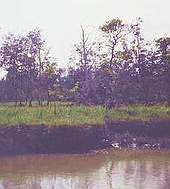The Dying Sundari Trees And Ban On Felling
 According to studies conducted by the World Resources Institute and the Centre for International Development and Environment for USAID and Bangladesh agriculture census, forest resources in Bangladesh are declining at a phenomenal rate.
According to studies conducted by the World Resources Institute and the Centre for International Development and Environment for USAID and Bangladesh agriculture census, forest resources in Bangladesh are declining at a phenomenal rate.
Considering this, plus the report of the wholesale felling of trees in the name of eliminating the infected Sundari trees by a section of local timber traders and a section of employees of the forest department, the parliamentary standing committee of the Ministry of Forest and Environment has asked the concerned authorities to stop felling all types of trees in the Sundarbans. Presided over by the committee chairman Nazimuddin Alam, the meeting also asked the forest experts to examine the reasons for the longstanding top-dying disease of Sundari trees and take steps to save the mangrove forest from further depletion.
The top-dying disease of the Sundari tree was first detected in 1930. The disease gradually spread and from 1991 to 1997, the top-dying trees were cut down from eight compartments. But cutting down the infected trees proved to be a waste of time because the trees that were cut down have been attacked anew. Now the experts say the Sundari trees of the Sundarbans will soon vanish due to the top-dying disease as it has spread to thousands of these trees.
Although some of the causes are known such as increased salinity in the soil as the Sundari trees need sweet water for regeneration, there is no prevention for this kind of disease, therefore the experts suggested cutting down affected trees, hoping this would prevent its spread but it did not happen. But finding a solution is urgent because the Sundari is the main species of tree in the forest. According to statistics, the productivity of the Sundarbans mangrove forest has declined by 25 per cent in a period of 25 years. This is a serious matter because the forestry sector contributes more than three per cent to the nation’s gross domestic product.
As mangroves require the steady rise and fall of the sea so that their roots can breathe. If this process is disrupted, the world could lose not only the trees but also the rich fisheries in the region, it is obvious that the world’s largest contiguous mangrove forest is on the brink of destruction. But planting plantations of coconut trees is not the answer. These are among the species that have a negative impact in social and environmental terms. As we have said before, plantations are not forests, and it is this that needs to be firmly understood.
And as for the illegal felling-the government has already suspended 15 employees of Khulna Range-nine forest rangers, deputy forest rangers and foresters and six forest guards-for their alleged involvement in felling trees and selling them in the market. At least one lesson has been learned-in allowing the uncontrolled and widespread clearing of the forest because of the top-dying disease we have also encouraged indiscriminate felling. With thousands of trees being chopped down every day, our forest cover is in danger, therefore the ban is timely but we must also find out what is killing our trees and find a solution
(The Bangladesh Observer, June 1, 2004)
Top
of page
Back to Environment
Sunderbans: The largest Mangrove Forest of the World
Back to Home Garden
Home
According to studies conducted by the World Resources Institute and the Centre for International Development and Environment for USAID and Bangladesh agriculture census, forest resources in Bangladesh are declining at a phenomenal rate.